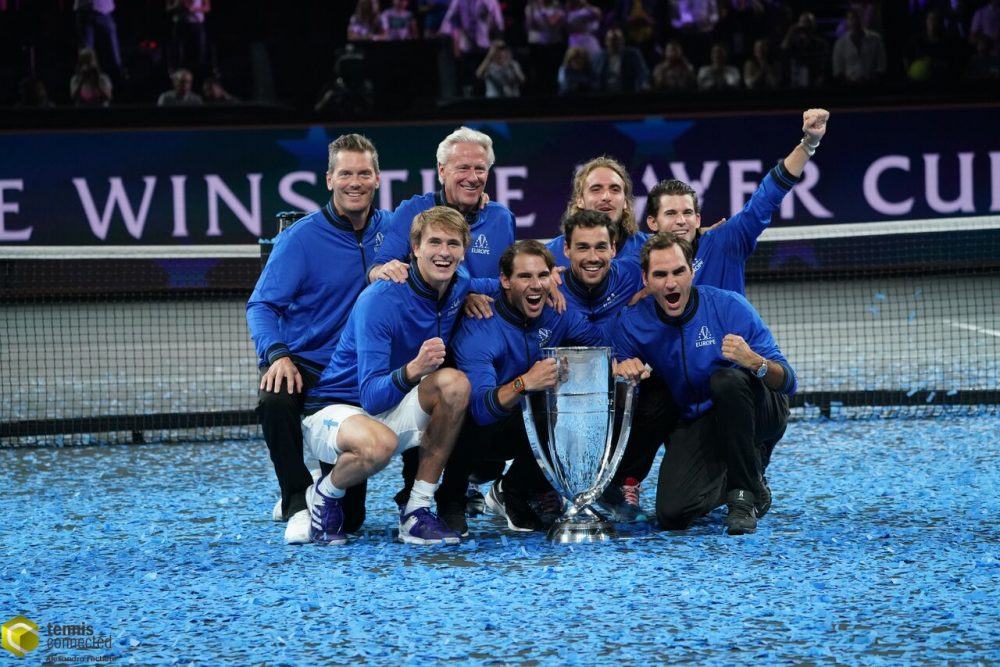Welcome to Tennis Elbow, the column that looks back on the week that was in the world of tennis. This week, Charles Blouin-Gascon recaps the 2019 Laver Cup.
It’s easy to fall in love at the Laver Cup.
This past weekend, men’s tennis held its third annual big circus where fans and pseudo fans from all walks of life are welcome, with something called Team Europe emerging victorious over another entity called Team World by the score of 13-11.
The event was held in Roger Federer’s kingdom in Switzerland and for the third time in as many tries, the players from Europe emerged victorious over their counterparts from outside of Europe.
Prague: ?
Chicago: ?
Geneva: ?It’s #TeamEurope‘s title once again! #LaverCup pic.twitter.com/PdNMIOgliS
— ATP Tour (@ATP_Tour) September 22, 2019
The Laver Cup emerged in 2017 a fully formed phenomenon with a simple enough formula that just about everyone even mildly interested in the sport would love: take 12 of the very best players in the world, including at least two of the three best in history since they are ageless, divide them into two teams and watch the magic happen.
And boy has it been magical.
Nadal: “Just, we need to be a little bit more clear…”
*Nadal contains laughter*
“…with the finger…”
*Federer and Nadal piss themselves laughing*
This is pure comedy gold.#LaverCup | #Tsitsipas pic.twitter.com/ehapNFKdTi
— Bastien Fachan (@BastienFachan) September 21, 2019
How has a seemingly throwaway of a tennis event with absolutely no strings attached become appointment television?
Well for the most part, the Laver Cup became appointment TV by having the powers that be treating their Cup like anything but a throwaway event. Their first order of business, naming their event, was their first stroke of genius: naming it after one of the sport’s most historically beloved superstar gave the event, if nothing else, as much cachet as you can muster out of thin air.
They also adopted a team formula, whereby fans of this deeply individual sport would see their favourite players compete with one another for a change. Novelty begat interest, right?
The success of the Laver Cup, however, can’t simply be explained with a clever name choice and a good formula: if it were, the Davis Cup—in its capacity as the foremost team event in tennis—would be a runaway hit rather than having to fight for its existence every year.
That said, armed with a good name and a great formula, folks from the Laver Cup reached out to two legends of the sport in Bjorn Borg and John McEnroe and gave them the role of captains of both teams, but really all they needed from the pair was for them to be involved some way.
Once Borg and McEnroe were in, then the Laver Cup had pull and could begin dreaming big. Because once they were in, then they could approach, say, Rafael Nadal and Roger Federer, perhaps the two most beloved players in history as well as deep and respectful students of the sport’s history—and that was, as they say, that. This is how you attract a pretty great lineup of players competing in your brand new event. And with the great fans come the rabid fans.
(This is neither here nor there, but Nick Kyrgios remains one of the most in-demand players on tour; it’s especially surprising considering how much the tennis world supposedly hates him just how often it keeps inviting him to the party.)
LOOK OUT, ROGER! ? ?@rogerfederer | @AlexZverev | #TeamEurope | #LaverCup pic.twitter.com/3bNR9DQEFO
— ATP Tour (@ATP_Tour) September 22, 2019
Above anything else, this edition of the Laver Cup may be best remembered as the tennis tournament with the thousands memes. Seriously, look at all of the meme-able moments it gave us over a three-day period; for a conservative sport like tennis, this is fairly notable.
The Laver Cup is currently in the very best sweet spot: it’s a novel enough event that we’re compelled to tune in regardless of what might happen—and it seems like every year, something entirely new and awesome happens again. This year, the very last match of the weekend was the one that would decide the winners and losers. Who knows, maybe next year we’ll be tied at 12 apiece and we’ll see a final decider?
If we do, we’ll see it all unfold Boston in 2020. Nadal and Federer will be one year older.
They’ll still compete though, don’t worry.
Follow Charles Blouin-Gascon on Twitter @RealCBG

























